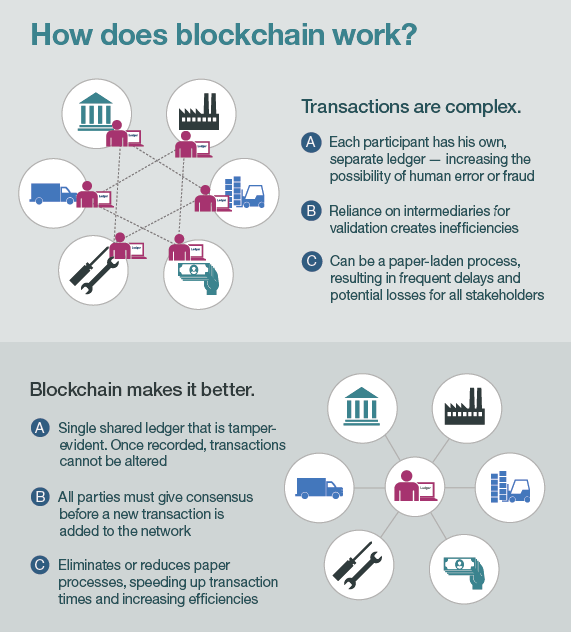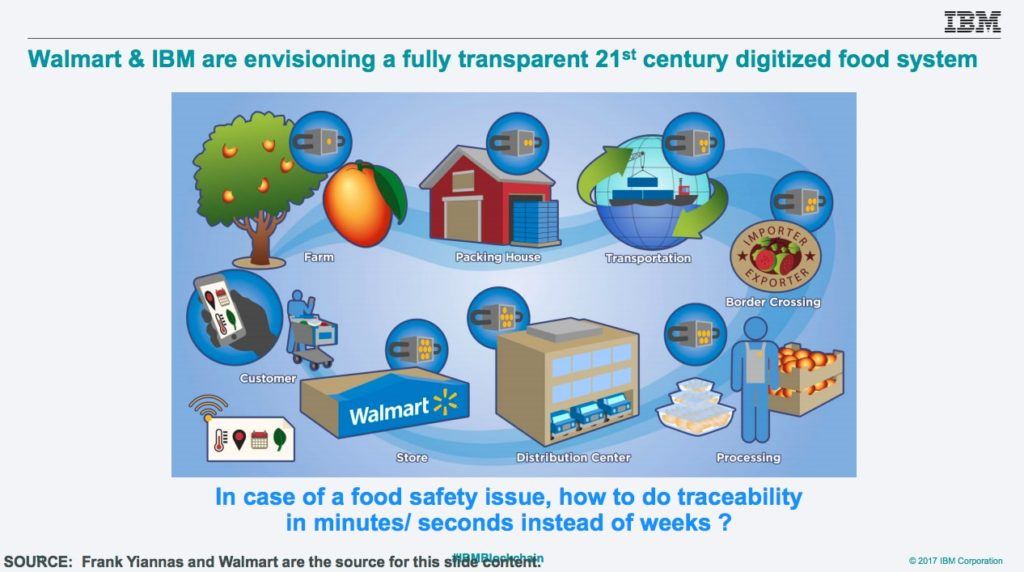Walmart and Block Chain: It Takes Two to Mango

Walmart is one of the largest retailers in the world with one of the most complex global supply chains. How are they using blockchain to revolutionize their ability to track food and drive value across multiple dimensions?
Introduction
While Walmart’s impressive scale of 11,695 stores across 28 countries utilizing over 100,000 global suppliers [1] creates key competitive advantages, it also drives significant health, reputation and financial risks should any safety contamination issues arise. Luckily for Walmart, the recent development of supply chain digitalization through blockchain will completely revolutionize Walmart’s business operations.
What is blockchain? A blockchain is a cross-party shared ledger which records a history of transactions and cannot be altered. The system utilizes a function which securely combines transactions into sequences of lists (blocks), helping to ensure that data is sound, verified and easily tracked. This differs from the traditional system, in which each entity separately maintains their own ledger, providing opportunities for inconsistencies and fraud. (See Exhibit 1.)
Exhibit 1 [2]
Why does Walmart care?
Walmart’s customers rely on them to provide safe products, and if an issue arises, Walmart’s reputation is at stake even if the issue is outside of Walmart’s control. Walmart has long searched for the “Holy Grail of food traceability” [3] to create accountability and detection across their complex supply chain, and the company has finally found a solution.
When a contamination issue occurs, due to the complexity of the supply chain, it can take weeks to identify the source of the problem. For example, a recent salmonella outbreak in Mexican papayas took two months to track down the source of the issue and recall the produce [4]. With blockchain, this process can be reduced to seconds, enabling for agencies to investigate faster and for companies to easily trace individual items, allowing for recalling only specific items at risk, as opposed to a broad recall. The benefits are widespread: (1) faster containment of illnesses through decreased response time, (2) increased revenue and decreased food waste through selective recalls, (3) improved regulation compliance through better tracking, and (4) enhanced trust amongst the supply chain through greater information sharing.
In August 2017, Walmart announced a blockchain partnership with IBM and a consortium of other food supply chain players, including Dole, Kroger, McCormick, Nestlé, Tyson Foods, Unilever, and more. The consortium will collaborate to find new applications to increase food traceability. Walmart has been the leader thus far, having already performed two trials with IBM in which they tracked pork in China and mangos in Mexico. In these trials, food safety processes and product information were digitalized on blockchain, creating a single historical record for the produce. These trials reduced the time to track information from one week to 2.2 seconds [5]. With such results in an industry with over 500 food recalls annually in the U.S. alone [6] and $10-15 billion annual spend on food safety incidents [7], this offers large financial and operational implications for all participants in the ecosystem. These trials will continue to run over the next few years as Walmart, IBM and the consortium further digitalize the food system. The long-term vision for Walmart is to create a fully transparent food supply chain (see Exhibit 2), which will take many years to fully develop.
Exhibit 2 [7]
Recommendations
Walmart’s application of blockchain will serve as a model for other supply chain organizations for many years to come. As Walmart forges ahead with its vision, the company needs to ensure that it continues to be broad in the potential use cases it explores, considerate in the impacts it has up and down the supply chain, and inclusive in collaborating with other players. Furthermore, new issues surrounding data storage and transport are likely to arise, which Walmart should be prepared to handle.
Due to the complexity of the food ecosystem, the IBM consortium should provide good collaboration and diverse perspectives around the technology. However, there are still players in the supply chain that are missing from the partnership, such as agricultural cooperatives and logistical distributors. The Company should be aware of these missing pieces as this may cause potential blind spots in their developmental phase.
Additionally, the advent of blockchain will create large caches of data as the ecosystem becomes digitalized. This will create massive demands on data storage and data transportation, requiring the Company to be thoughtful in tracking and sharing only information which will be useful as opposed to tracking all possible available information. This will help optimize the inevitable demands to be created on technology infrastructure.
Conclusion
Walmart is positioned to be a thought leader in this space. However, as Walmart works towards its vision, it also needs to consider a number of open questions: How will the company create buy-in, both across the food ecosystem and within its own organization, for a technology that is currently not widely understood? What financial investments will be required to digitalize and implement blockchain, and how will this impact the ability for smaller players to participate?
Word count: 795 words
Bibliography
[1] Wal-Mart Stores, Inc., 2016 10-K Filing, Securities and Exchange Commission.
[2] IBM, “Blockchain 101 Infographic,” [Online]. Available: https://www-01.ibm.com/common/ssi/cgi-bin/ssialias?htmlfid=XI912346USEN&.
[3] R. Hackett, “Why Big Business is Racing to Build Blockchains,” Fortune Magazine, 22 August 2017.
[4] U.S. Food & Drug Administration, “FDA Investigates Multiple Salmonella Outbreak Strains Linked to Papayas,” 4 November 2017. [Online]. Available: https://www.fda.gov/Food/RecallsOutbreaksEmergencies/Outbreaks/ucm568097.htm.
[5] M. Unuvar, “The food industry gets an upgrade with blockchain,” 15 June 2017. [Online]. Available: https://www.ibm.com/blogs/blockchain/2017/06/the-food-industry-gets-an-upgrade-with-blockchain/.
[6] Statista, “Food recalls in the U.S.,” Statista, 2017.
[7] D. Galvin, “IBM and Walmart: Blockchain for Food Safety,” IBM, [Online]. Available: https://www-01.ibm.com/events/wwe/grp/grp308.nsf/vLookupPDFs/6%20Using%20Blockchain%20for%20Food%20Safe%202/$file/6%20Using%20Blockchain%20for%20Food%20Safe%202.pdf.





This is a timely topic, especially since Bitcoin just crossed the $10,000 threshold, up 900% since the start of the year! However, with all the hype around crypto-assets and blockchain technology, there are many questions as to why for some applications it’s a better approach than centralized cloud-based databases. It is great to see that Walmart and other food supply-chain players are exploring its potential, but I hope that Walmart is also considering more traditional approaches to data management as they might find blockchain tech to be prohibitively under-developed or expensive. Yes, blockchain creates a single distributed, historical record / ledger of transactions, but it also has many downsides that make it a sub-optimal technology for certain applications: transaction times can take several minutes as transactions are validated by the network (https://blockchain.info/charts/median-confirmation-time), significant security concerns (e.g. network hacks), hard to trace, non-recoverable assets (e.g. if you lose a physical asset or you’re hacked). I’m excited that Walmart is exploring how to use blockchain in its supply chain, I just hope it’s also looking at solving traceability problems through more traditional methods as well.
I agree with Edwards above that this is a timely topic. At this time blockchain technology is in the early stages of its life and many companies including Walmart are in the midst of figuring out how to apply it to their business. However, I think this is were Walmart should rely on emerging companies within the blockchain space to develop solutions for them, as opposed to entering a field that is not within their core competencies. I think the partnership with IBM is powerful, but Walmart should also look into investing into start-up companies within the blockchain community that are working on solving supply chain issues. In the short term, as Edwards suggested, I would recommend Walmart focus on leveraging existing solutions to tackle some of their current problems. While I agree that blockchain is the future and Walmart is being proactive by paying attention to it, I think there is technology out there that they could apply today to solve some of their supply chain problems.
Really interesting concept! The big question for me is why do you need a distributed ledger here? It feels like a strong database that tracks individual suppliers would be sufficient for Walmart, unless the concept is trying to get all retailers to have a central information hub to track failures with produces. If this is the goal, then I would be interested to understand any potential concerns that retailers have with sharing their supplier and distribution data.